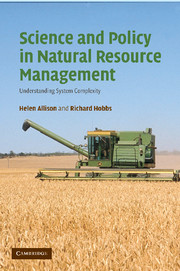Book contents
- Frontmatter
- Contents
- List of illustrations
- List of tables
- Foreword
- Preface
- Acknowledgements
- List of abbreviations
- 1 Introduction
- 2 Historical and policy context
- 3 Natural resource degradation: a resistant problem of the twentieth century
- 4 The epistemology of natural resource management of the twentieth century
- 5 A contemporary epistemology and framework for natural resource management of the twenty-first century
- 6 Model conceptualisation of the Western Australian agricultural region. Part 1: resilience analysis
- 7 Model conceptualisation of the Western Australian agricultural region. Part 2: system dynamics
- 8 Synthesis
- Epilogue
- Glossary
- References
- Index
7 - Model conceptualisation of the Western Australian agricultural region. Part 2: system dynamics
Published online by Cambridge University Press: 01 March 2010
- Frontmatter
- Contents
- List of illustrations
- List of tables
- Foreword
- Preface
- Acknowledgements
- List of abbreviations
- 1 Introduction
- 2 Historical and policy context
- 3 Natural resource degradation: a resistant problem of the twentieth century
- 4 The epistemology of natural resource management of the twentieth century
- 5 A contemporary epistemology and framework for natural resource management of the twenty-first century
- 6 Model conceptualisation of the Western Australian agricultural region. Part 1: resilience analysis
- 7 Model conceptualisation of the Western Australian agricultural region. Part 2: system dynamics
- 8 Synthesis
- Epilogue
- Glossary
- References
- Index
Summary
… social systems are inherently insensitive to most policy changes that people choose in an effort to alter the behavior of systems. In fact, social systems draw attention to the very points at which an attempt to intervene fails. Human intuition develops from exposure to simple systems. In simple systems, the cause of a trouble is close in both time and space to symptoms of trouble. However, in complex dynamic systems, causes are often far removed both in time and space from symptoms. True causes may lie far back in time and arise from an entirely different part of the system from when and where the symptoms occur. However, the complex system can mislead in devious ways by presenting an apparent cause that meets the expectations derived from simple systems. However, the apparent causes are usually coincident occurrences that, like the trouble symptom itself, are being produced by the feedback loop dynamics of a larger system.
Jay W. Forrester, 1995Introduction
Regional pathology is a common phenomenon of resource management in social-ecological systems (SESs) (Holling and Meffe, 1996; Holling et al., 2002c; Jansson and Jansson, 2002). Holling (1995) showed that, in 23 cases examined, the conditions that caused growth in natural resource systems and accounted for their success ultimately were the same conditions that were responsible for their collapse. Two pathologies, the Poverty Trap and the Rigidity Trap, have been described that can occur as a result of the collapse of the adaptive cycle (Holling et al., 2002c).
- Type
- Chapter
- Information
- Science and Policy in Natural Resource ManagementUnderstanding System Complexity, pp. 149 - 176Publisher: Cambridge University PressPrint publication year: 2006



